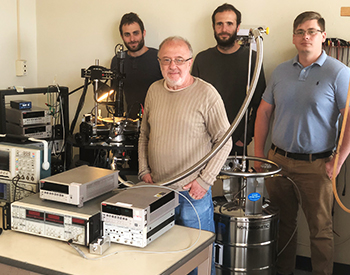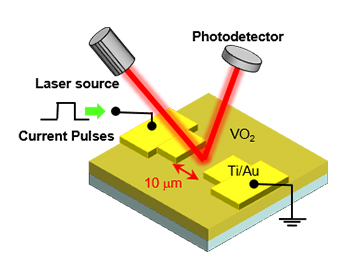Hardwiring computers for human-brain efficiency
UC San Diego scientists work to create materials for neuromorphic computing
May 9, 2019 | By Ariana Remmel
 Back row, left to right: postdoctoral scholars Javier del Valle, Yoav Kalcheim and Pavel Salev; Professor Ivan Schuller stands in front. Photo courtesy of Javier del Valle
Back row, left to right: postdoctoral scholars Javier del Valle, Yoav Kalcheim and Pavel Salev; Professor Ivan Schuller stands in front. Photo courtesy of Javier del Valle
While the human brain has inspired innovation in science and technology over the last century, one of its best kept secrets is its efficiency. Our brains process complex data with the energy from a latte—something our most powerful computers can’t accomplish with millions of dollars’ worth of electricity from the grid. But a team of international scientists led by UC San Diego’s Ivan Schuller is changing the way we think about computing. He and his colleagues at Quantum Materials for Energy Efficient Neuromorphic Computing (Q-MEEN-C) are designing neuromorphic computers whose hardware mimics the neuronal networks of living brains. The findings of his team’s latest research on its efforts to design the hardware behind this revolution was published recently in Nature.
Javier del Valle, postdoctoral fellow in the Schuller Nanoscience Group, led the efforts on the team’s recent discoveries. “There’s a lot of basic science that has to happen, a lot of questions we have to address, before we can make neuromorphic computing a reality,” says del Valle, whose work has focused on the material components that can one day be used as “neurons” within the computer network.
Neurons respond to pulses of electricity that cause them to fire, thus propagating the signal through the neuronal network. While our bodies can use nutrients from a latte to power firing neurons, neuromorphic components need electricity directly from the grid. Del Valle wanted to know how components of vanadium oxide—an inorganic compound used as a catalyst in industrial processes—would respond to spikes of energy like a neuron might experience in the body.
 Experimental setup used for measuring the memory effect: a voltage pulse triggers the insulating to metal transition, while a laser is used to monitor the sample's reflectivity. Image courtesy of Javier del Valle
Experimental setup used for measuring the memory effect: a voltage pulse triggers the insulating to metal transition, while a laser is used to monitor the sample's reflectivity. Image courtesy of Javier del Valle
“What we found is that once you make the device fire, it has a memory of that firing that lasts for a long time,” which lowers how much energy is needed to fire the component a second or third time, making it easier to fire the component with less voltage, explained del Valle.
This result surprised the scientists, partially because it was discovered by accident. Del Valle said he was running a routine experiment where the component was exposed to increasing, then decreasing spikes of voltage. Once the components had been exposed to higher voltages, however, it could be induced to fire with lower voltages than originally recorded. This simple observation led the scientist to design a rigorous set of experiments that were corroborated by computational simulations run by collaborators in France. Del Valle’s findings lead to more research questions.
“We could benefit from this effect and list a couple of those benefits in the paper,” del Valle remarked, “but at the same time it could be a problem for reproducibility at high speeds.” He said he plans to continue investigating this problem by better understanding the mechanisms behind these results, thus gaining greater control over the system.
Del Valle helped with two other papers published this year by the Schuller Group. Yoav Kalcheim, postdoctoral fellow, published results in Physical Review Letters in February, showing that changes in the physical structure of the vanadium oxide components directly correlates with altered electronic properties. In April, Pavel Salev, postdoctoral fellow, published a report in the Proceedings of the National Academy of Sciences describing hybrid materials that could lead to better control over the properties of these materials by applying a gate voltage. All of these findings bring us closer to functioning neuromorphic computing devices.
Schuller has overseen this research as a UC San Diego Distinguished Professor of Physics and the director of Q-MEEN-C, one of 42 Energy Frontier Research Centers (EFRC) funded by the Department of Energy (DOE) in 2018. The center has been awarded nearly $10 million dollars over four years to help innovate and develop critical energy technologies.
This research was supported by the Vannevar Bush Faculty Fellowship programme, sponsored by the Basic Research Office of the Assistant Secretary of Defense for Research and Engineering and funded by the US Office of Naval Research (grant N00014-15-1-2848); the Quantum Materials for Energy Efficient Neuromorphic Computing, an Energy Frontier Research Center funded by the US Department of Energy, Office of Science, Basic Energy Sciences (grant award DE-SC0019273); the U.S. National Science Foundation (grant ECCS-1542148); FAPA and Colciencias (no. 120471250659) and from a fellowship by the Fundación Ramón Areces.
